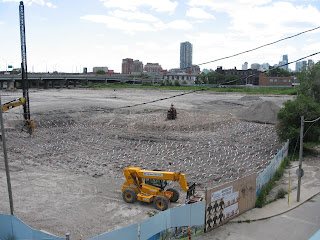
Treasure hunters leave big mess just south of Chester Springs Marsh
An alert from a fellow Don Watcher led me to investigate an area near Chester Springs Marsh, one of the Task Force's earliest restoration sites. When I arrived on site, I was surprised to find an area about 5x10m strewn with rubble and debris. In the centre of this mess is an impressive hole about 4m deep. At the bottom of the hole a shovel is visible. Although well off the path, the hole would be difficult to climb out of even for a tall guy like me.
It's a well known fact that this area is was a former dump from the days of the Don Valley before organized municipal garbage collection. Chester Springs Marsh has had treasure seekers digging before and signs have been posted warning that such activities are illegal. I suppose the diggers took advantage of the civic worker's strike and did their excavations when there were fewer eyes to keep watch over the site.
The site is a hazard and will be expensive to cleanup. I find it ironic that during a time when the Don is once again the repository for new dumps that somebody would take it upon themselves to remove some garbage.

4 metre deep hole is pretty impressive. Warning: don't get too close because the sides of the hole at the bottom are collapsing.

Discarded bottles and other detritus litter the area. I wonder if they found anything valuable?
































